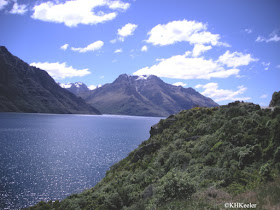New Zealand! An intriguing destination, far south of the Equator, across the Pacific Ocean, and yet reputedly very British. We traveled with Betchart Expeditions, led by Lloyd Esler. (Tour description!)
It was a long airplane flight and I disembarked expecting it to be exotic. But the first plants I saw were familiar ones. Cosmopolitan weeds, in fact.
Here is Plantago lanceolata, narrow-leafed plantain (plantain family, Plantaginaceae), found all over the world (see post on plantain).
 |
| Narrow-leafed plantain, Plantago lanceolata |
 |
| cranesbill Eriodium cicutarium |
Gardens featured roses and iris. (The iris seemed a little odd, it was November.)
But just as I got to feeling comfortable that I knew the plants, I found ones I didn't know.
The beautiful shrub in the photo below has flowers characteristic of the proteus family, Proteaceae. The Proteaceae are a Southern Hemisphere family that is only starting to show up in the North American horicultural trade and most are too frost-sensitive for Colorado. So I recognized the family but not the plant. (About Proteaceae: I like the pictures in Wikipedia link).
Family resemblances are why botanists like to tell you the plant family: you might not know the plant but you may well know the family. In the case of the Proteaceae, residents of Northern Hemisphere, temperate regions are not likely to know the family either.
New Zealand is a pair of good-sized islands (For perspective for North Americans, the North Island is just larger than Virginia ; the South Island larger than Illinois, they would be the 25th and 35th largest states in the United States) and some tiny ones. As islands, they have with lots of spectacular coastline:
But just as I got to feeling comfortable that I knew the plants, I found ones I didn't know.
The beautiful shrub in the photo below has flowers characteristic of the proteus family, Proteaceae. The Proteaceae are a Southern Hemisphere family that is only starting to show up in the North American horicultural trade and most are too frost-sensitive for Colorado. So I recognized the family but not the plant. (About Proteaceae: I like the pictures in Wikipedia link).
Family resemblances are why botanists like to tell you the plant family: you might not know the plant but you may well know the family. In the case of the Proteaceae, residents of Northern Hemisphere, temperate regions are not likely to know the family either.
Then, I didn't know these grasses. My reading said before all the introduced plants were established by colonists, large sections of New Zealand had native bunch grasses. There were natives in this little park so I imagined these were too.
Here is a shrub with nasty spines. New Zealand had no native land mammals other than a bat, so the plant-eaters were birds. Most of the big ones, moas for example (pictures), are extinct. So we don't think to wonder about how the plants defended themselves from being eaten. But New Zealand botanists point to a high frequency of very spiny plants and other plants whose branches grow inward, forming a thicket in which leaves are protected by a tangle of strong stems. It was probably very effective against big birds. Today the plants are extremely difficult for humans to walk through or push aside as well.
I had a grand time. It was a continous mix of familiar and unfamiliar. We'd have easy conversations with passersby about being tourists, and then they'd ask if we were tramping. Tramping? They tramp a trek where we'd take a hike.
And their pronunciation gave me wonderful double-takes. I couldn't find "Oakland" on the map. That's because it is spelled Aukland. I looked for the hog farms in "Piggydale," to discover it is Peggydale.
and then the tour stopped at this park, where all the ground was totally covered by a beige moss. I'd never seen an ecosystem like that.
 |
Some places there were flocks of familiar-looking shorebirds (though in fact few were species I see in North America)
but many birds were quite unfamiliar.
I had looked forward to seeing the kea. I think I first learned of kea as a useful Scrabble word. But they are famous parrots, endemic to New Zealand, better able to live in cold conditions than any other parrot.
Parrots are very intelligent birds, and that is not a characteristic that endears them to people who live with them. Keas create considerable damage to anything outdoors that catches their eye, including, for example, destroying the the insulation around car windows and the tires of parked cars.
 |
| Kea |
Comments and corrections welcome.
Kathy Keeler
More at awanderingbotanist.com
Join me on Facebook: https://www.facebook.com/AWanderingBotanist









No comments:
Post a Comment